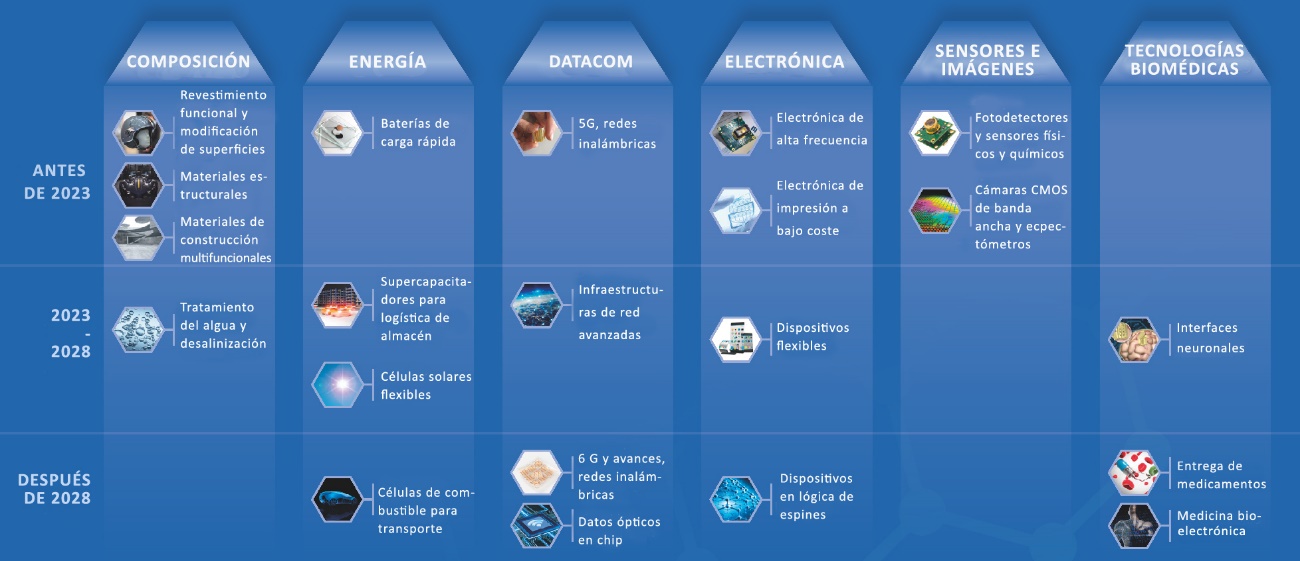Graphene, the first man-made two-dimensional material, is expected to transform different industries, from energy to electronics, including the fields of biomedicine and aerospace, as it has a number of qualities that make it unique in the world. The transition in his implementation in research centers to mass industrial production is the main challenge for an innovative element that many public bodies and private companies throughout the world are wagering on.
Although we have been aware of graphene since the 1930s (time when its chemical bond and structure were described) for decades it was neglected because it was considered to be thermodynamically unstable. That is why it was a veritable scientific revolution when, in 2004, Andre Geim and Konstantin Novoselov were able to isolate graphene at room temperature, extracting a single carbon atom sheet from graphite. Six years later, the Russian scientists were awarded the Nobel Prize for this finding.
Since then, research about this material has multiplied in all corners of the planet. Many experts consider it the material of the future as it is very abundant and has revolutionary properties:
– Extremely light. It is one million times thinner than a sheet of paper and a square meter sheet weighs only 0.77 grams. “It is the thinnest material ever developed,” stated Mar García Hernández, a research professor at the CSIC’s Institute of Material Sciences in Madrid, up to the point that “with a gram of graphene we could cover a third of a soccer field.”
– Very strong. It is the hardest known material. It has a mechanical resistance of 42 N/m (tensile strength), while a sheet of steel with the same thickness would have a resistance of approximately 0.4 N/m.
– Flexible. A sheet can be reversibly stretched by 10% of its normal size and can be bent without damage up to 20%.
– Practically transparent, but dense. Not even a helium atom, the smallest that exists, can pass through its holes (between the carbon atoms).
– Superconductor. It conducts electricity very well and is the best known conductor of heat. Its thermal conductivity is 5,000 W/mK, greater than copper, diamonds, or silver, which allows it dissipate heat and withstand high electrical currents without heating up.
– Impermeable. Graphene sheets have carbon atoms that are so closely linked that they can be used as super fine atomic nets, blocking other materials from passing through.
– Chemically inert. It does not react with oxygen in the air and does not rust.
– It does not pollute. It is pure carbon, extracted directly from nature.
– Biocompatible. It is not toxic to living cells, which makes it more appealing to use in the field of medicine.
Industrialization of graphene
All of these properties have helped graphene to be known as the “miracle material,” and the opportunities for technological innovation that it offers have been praised by both the scientific and industrial communities for the improvements in productivity, efficiency, and profitability that its use could bring about. All of these factors have led its demand to skyrocket in recent years, although it still has one large obstacle: there is an insufficient supply.
Because it is extremely light, strong, flexible, and a superconductor, its properties are particularly sought out by industry
García Hernández brought to the fore one of the significant challenges that graphene faces in the future: producing it “free of flaws and at a low cost.” Nonetheless, obtaining it is relatively easy, either through exfoliation or from different carbon-based sources, as carbon is one of the Earth’s most abundant materials. However, its production is not progressing more quickly because producing a high-quality material (one that offers graphene’s qualities) requires complicated and expensive synthesis processes.
“The process for it to be industrialized has slowed because, although industrial-level graphene synthesis has progressed significantly, the price of some of the ways in which it is made continues to be high as the market is still undeveloped. Its production, therefore, does not benefit from an economy of scale,” the CSIC researcher stated.
That is why laboratory and industrial-scale studies are more restricted. In fact, some prototypes have already shown that graphene batteries can be developed that are 10 times more powerful than current batteries, or camera lenses that are 1,000 times brighter, but the costs to produce them are too high for large quantities.
Therefore, current research is aimed at finding methods of producing graphene that are less expensive, larger scale, and higher quality, such as the method discovered by experts at the University of Illinois to produce this material from carbonated water; or Rice University’s method, which extracted high-quality graphene from table sugar heated to 800°C (1472°F); or the method of the Institute of Physical Chemistry of the Polish Academy of the Sciences, which uses ultrasound to create oxidized graphene sheets and graphene flakes.
What does the future hold?
The CSIC researcher highlighted this material’s integration with conventional technology, such as silicon-based electronics, as a key step in the future: “We expect to be able to produce electro-optic modulators that can help create more agile telecommunication systems,” García Hernández indicated. However, graphene conducts heat 100 times faster than the silicon used in chips, which could in turn produce processors that are 10 times faster, lighter, and more efficient.
Yet, “the integration of graphene in many applications must compete with other, well-developed technologies that have had decades of continuous investment. It will therefore be difficult to implement in those sectors because it would mean changing production chains and value chains that are extremely well established. And that is very expensive,” García Hernández underscored.
In universities and research centers, they are now performing trials to manufacture airplanes with a graphene cover on the wings to reduce the total weight of the aircraft.
With all this, the research has helped graphene to be used as a mechanical reinforcement of polymer composites to improve their properties, which would create stronger, more conductive materials that are particularly interesting to the arms, automobile, and aerospace industries. The last industry mentioned is benefiting especially from progress in combined use of graphene in other composites such as fire retardant, and zero gravity testing has begun to drain heat from the elements producing it.
These three industries, in which the predicted uses are very promising, are not alone. “Very interesting tests are being done to use graphene as a flexible, minimally invasive electrode in brain tissue. Another very active field is graphene-based sensors to make wearables in the biomedical and environmental fields. Applications in batteries, supercapacitors, and fuel cells are being developed,” García Hernández noted.
At universities and research centers, trials are now being performed to manufacture airplanes with a graphene cover on the wings to reduce the total weight of the aircraft; graphene foam created with carbon nanotubes that is light and flexible but can hold up to 3,000 times its own weight without breaking; and bullet-proof vests made with two layers of graphene and an underlying layer of silicon with a thickness similar to aluminum foil. These are some of the revolutionary applications of a material that, after years of research, will show its extraordinary potential in the coming years with large-scale industrialization.
Future applications of graphene

Source: “Graphene Flagship. Annual report 2017,” by Graphene Flagship
Graphene Flagship Initiative
Although the creation of graphene-based applications is more developed in Korea and China, where there is a higher number of patents registered, García Hernández is pleased to say that Europe is leading the scientific race internationally, thanks to the creation of specific programs, like Graphene Flagship.
This initiative, the largest research initiative in the EU with a 10-year duration, has a budget of 1 billion euros and network of 150 academic and industrial research groups. It represents a new form of joint research coordinated on an unprecedented scale.
Launched in 2013, it is now halfway into its term “with significant progress and expectations in the development of many applications,” such as the integration of graphene into optoelectronics, in conditions similar to those required in that industry, according to Mar García Hernández who leads the project’s Material Work Package. The researcher also praised the significant developments in the field of polymer composites for mechanical reinforcement and conductive polymers for electricity and heat.
Along these lines, the research projects are focused on functionalizing graphene for biomedical applications, such as specific biological molecule sensors. Progress is also being made on directly synthesizing it onto substrates that do not conduct electricity, like conventional glass, and onto silicon wafers and that are used in electronics or onto titanium dioxide for use in photovoltaic cells.
This article was written with assistance from:

Mar García Hernández (Madrid, 1959), CSIC research professor. She received her doctorate from the CSIC’s Institute for the Structure of Matter and has worked at the J. Heyrovsky Institute (the Czech Academy of Sciences, Prague), the Swiss Federal Institute of Technology Lausanne, and the Rutherford Appleton Laboratory (Oxfordshire, UK).
Her research into experimental condensed-matter physics began in disordered systems and is now focused on strongly correlated low-dimensional systems. She has directed the Laboratory of Magnetism and Magnetic Transport at the CSIC’s Institute of Material Sciences in Madrid since 2008.
She is the leader of the Material Work Package for the European Community’s Flagship project. She has published more than 270 scientific articles in international journals, directed numerous research projects, both in Spain and elsewhere in Europe, as well as doctoral theses, and is the co-author of several patents. She has been the scientific director of the Arquimedes competition to promote research among undergraduate and graduate students since 2007. She is the coordinator for the Spanish Graphene Alliance and she received the Innovative Researcher award from the Foro de Empresas Innovadoras in 2017.





